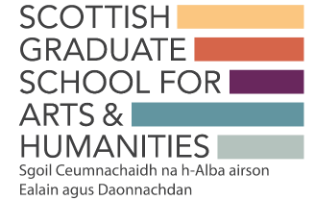Literary landmarks within Gray’s writing
Published: 16 September 2021
Literary landmarks within Gray’s writing
Organisation
The Alasdair Gray Archive was established in March 2020 after Gray’s death in late December 2019. The Alasdair Gray Archive exists to enhance the reputation and understanding of one of Scotland’s most significant cultural polymaths of the 20th century, and through his legacy support young people and other individuals to fulfil their potential in the creative sector. One of the core aims is to foster, promote and develop education opportunities in relation to the work of Alasdair Gray via series of student placements.
Location
In person but some time could be spent offsite recording/visiting sites. Open to discussing hybrid working if better suited for the placement students needs.
Project
The Archive is keen to map Gray’s work and how it is deeply embedded within the city of Glasgow. Gray and Glasgow are inextricably linked but what are the key landmarks in the city that Gray used as a source of inspiration for his literary works? This placement would seek to explore this in relation to Gray’s literary works. What were the Glasgow landmarks that Gray returned to and how can we evidence their impact on his written practice through mapping this in the archival material, photographs and materials contained within the AGA. Time would be spent making creative links between the material held within the Archive, generating content and thinking of creative ways in making this accessible to a wider public, physically, digitally and through social media platforms. Students will be able to handle and view original artworks and material so an enthusiasm for the subject matter would be useful and allow more meaningful connections. The Archive will run through all systems as well as the handling of ethical issues, confidentiality issues, intellectual property rights and copyright agreement. Our organisational values reflect the values by which Alasdair lived & worked and we reflect these in how we approach and work with others. These values of equity, openness and sharing enable outcomes to be shaped by others and for us to learn by sharing and working together. This is an essential part of this placement and the selected student will have the opportunity to work alongside others including our PhD Collaborative Doctoral Candidate for 2022, Lauren Forde. The Archive is keen to support the selected student to find a meaningful line of enquiry that supports their own research interests and to acknowledge their contribution to what is produced. An example of this collaborative approach to working is the new podcast series, ‘Unlikely Objects, Mostly’, our 2022 SGSAH student Christopher Silver produced during the course of his placement, A collection of everyday objects followed Alasdair Gray for long periods across the different rooms of his life, often appearing within the imagined worlds he conjured up as familiar motifs and devices.
They now occupy prominent places within the Alasdair Gray Archive. In this new podcast series, we used these objects to draw together memories from Alasdair’s friends, colleagues and collaborators. In doing so, we explore deeper connections between the artist’s own assembled world, his day-to-day practice, his home city and his commitment to socialism. Listen here, https://open.spotify.com/show/5IBzjeKpKw20pV4MBFEi25
Outputs
- Clear research aims/goals
- Generating new content: artwork/performance/event/resources
- Thinking through accessibility and making this visible (physical and digital)
- Reflective blog sharing their research journey
Timescale
Flexible - Ideally 1-2 days per week
Benefits to the Host
The Archive has developed its organisational strategy detailing its plan for the next 3-5 years. A priority for 2023 is to offer researchers new research opportunities, offering advanced pedagogical & financial opportunities. It also ties in with our longer term plans to make Gray’s work accessible to a wider audience and increase opportunities for new audience engagement. This project would generate the essential research material required to develop new content to then share more widely.
• Creating new content
• Creative links between art forms
• Making heritage accessible
• Capturing oral histories/narratives around objects
• Enriching the archive both physically and through the digital experience.
• Creating meaningful access (digital/physical)
• New research, sharing this through reflective blog posts and other accessible routes
• Making the archive more accessible both digitally and physically
• Collaboration; knowledge exchange, peer to peer learning
Benefits to the Researcher
- Mouldable outcomes; the student shaping these outcomes
- Collaborative learning; sharing and learning from others that are connected via our Gray networks
- Professional and personal development
- Extended network
- Creative development; an opportunity to creatively explore new and existing content and thinking through creative ways of sharing this publicly
Key Relationships
The student will work closely with Sorcha Dallas, Custodian of the Archive. However the student will work alongside other researchers (namely our PhD Collaborative Doctoral Candidate for 2022, Lauren Forde) and post graduate/under graduate student placements (from Strathclyde University, Glasgow University, Glasgow School of Art and Edinburgh College of Art amongst others) so there is real opportunity for cross subject collaboration, knowledge exchange and peer to peer learning.
- Mentor, Sorcha Dallas
- Lauren Forde (PhD Collaborative Doctoral Candidate, with Strathclyde University)
- Post grad and Under grad students (from Strathclyde University, Glasgow University, Glasgow School of Art and Edinburgh College of Art amongst others)
- Gray Research Network of academics, writers, artists and supporters
- Visitors to the Archive
- Friends/family members of Alasdair Gray
- User groups to the Archive
- Other research institutions and archives with an interest in Gray
- Wider public
First published: 16 September 2021



